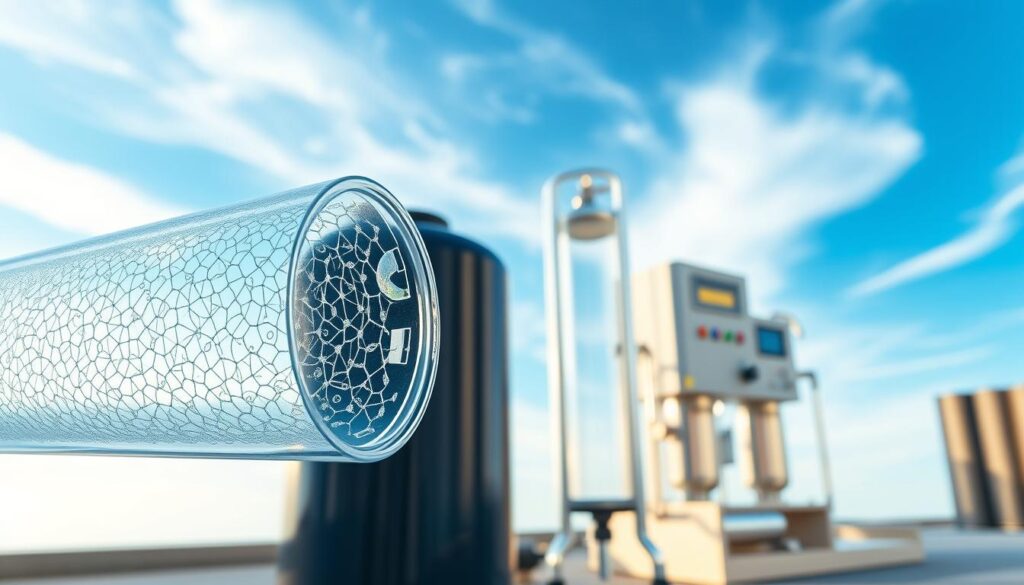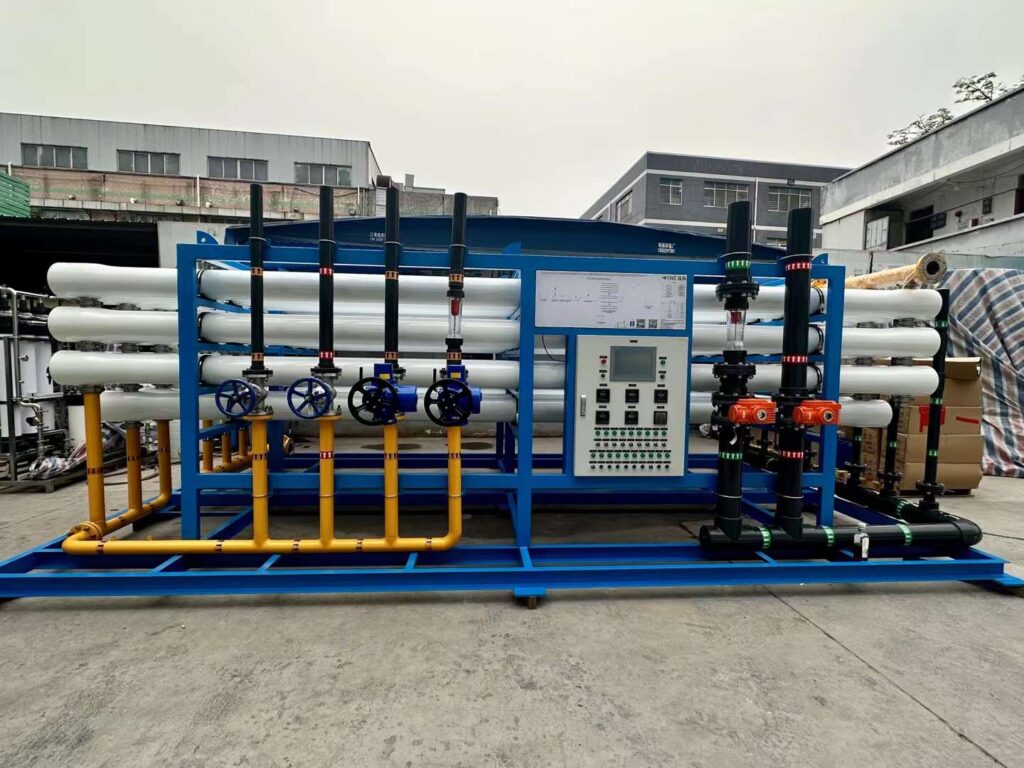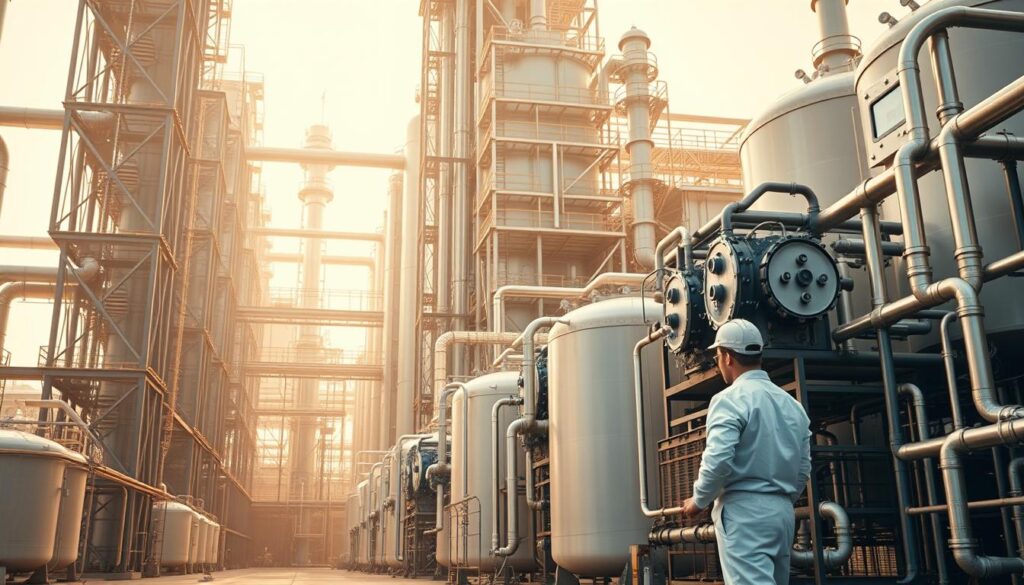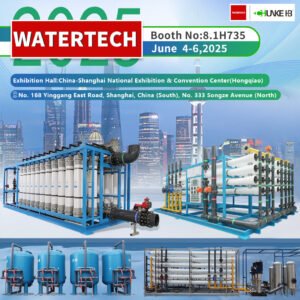Discover meaning of reverse osmosis with Chunke. We are Chunke Water Treatment, a top water treatment system maker from Guangzhou, China. We focus on Reverse Osmosis Systems, Ultrafiltration Systems, and more. Our goal is to help you understand reverse osmosis.

Reverse osmosis is a way to purify water. It uses a special membrane to remove bad stuff from water. This process is key to making water safe to drink1.
We aim to give you a clear view of our products and services. We explain why reverse osmosis is important. It helps remove harmful stuff from water, making it safe for us to drink.
Important Points
- Reverse osmosis is a water purification process that uses a partially permeable membrane to separate ions, unwanted molecules, and larger particles from drinking water.
- We can remove up to 99% of harmful contaminants from water1, making it a crucial step in the reverse osmosis process.
- Reverse osmosis systems are available in three sizes: countertop, under-the-sink, and whole house1.
- High-quality reverse osmosis systems typically waste 1 gallon of water to produce 1 gallon of purified water1.
- Reverse osmosis system canisters and lines should be changed every 5 years to prevent leaks and potential damage2.
- The removal of contaminants includes lead, hexavalent chromium, sodium, copper, chloride, mercury, dangerous viruses, harmful bacteria, and protozoa1
Understanding the Meaning of Reverse Osmosis
Exploring water purification, it’s key to know how reverse osmosis works and its perks. Understanding how it removes contaminants and sediments is vital. It uses pressure to push water through a membrane, removing unwanted stuff3.
Some important features of reverse osmosis systems include:
Knowing how reverse osmosis works, meaning of reverse osmosis and its benefits shows its value in clean drinking water. It’s a powerful tool for purifying water by removing many contaminants and sediments3.
The Evolution of Reverse Osmosis Technology
Reverse osmosis technology has made big strides over the years. It’s now a top choice for cleaning water. The history of reverse osmosis shows it started with the U.S. Navy to make drinking water from seawater for submarines5. Now, it’s used in many fields like food, beverages, and water recycling to provide clean water and manage resources well.
Improvements in making membranes and engineering have driven the growth of reverse osmosis. Today’s RO units use membranes, carbon, and mechanical filters to clean water better5. New materials and designs have also made RO systems work longer and better. For example, some systems can remove almost all 90 contaminants, including harmful substances like fluoride and lead6.
Here are some key statistics about reverse osmosis technology:
- Up to 99.99% of 90 contaminants can be removed, including fluoride, arsenic, chlorine, and lead6
- RO systems can remove up to 98% of common contaminants, including fluoride, salt, chlorine, arsenic, herbicides, and pesticides7
- Modern RO units combine membrane technology with carbon and mechanical filtration, making them more efficient and effective5

In conclusion, reverse osmosis technology has become a key method for purifying water. It can remove many contaminants, improve water taste, and lower health risks. As research and development keep improving, we’ll see even better RO systems in the future. This will make clean water available to everyone7.
Core Components of a Reverse Osmosis System
A reverse osmosis system has key parts like membrane types, pressure vessels, pumps, and filters. It’s made to remove up to 99% of harmful stuff, like arsenic and chlorine8. These parts work together to make sure the system works well.
Other important parts include pressure vessels and pumps. They help push water through the membrane. Filters before and after the membrane also help clean the water and make it taste better.
Some systems also have extra features, like permeate pumps. These can cut down on wastewater by 75 to 80%8. Knowing about these parts helps us see how well a reverse osmosis system works.
How the Reverse Osmosis Process Works
The reverse osmosis process uses a special membrane to clean water. This membrane blocks bad stuff like ions and big particles from water10. It makes water safe to drink by removing harmful substances.
This method can get rid of up to 99% of bad stuff in water. It removes things like arsenic, chlorine, and PFAS10.
This clean water meets the EPA’s standards for quality10.
Applications of Reverse Osmosis in Modern Industry
Reverse osmosis (RO) technology is key in many fields, like commercial, industrial, and home use. It helps in making clean drinking water and treating water for industrial processes. RO systems can remove up to 99% of harmful stuff like arsenic and chlorine12.
RO systems save water, improve water quality, and save money over time14. As the need for clean water grows, so will the use of RO technology in industry.
Benefits and Advantages of Reverse Osmosis Filtration
Reverse osmosis filtration has many benefits. It removes contaminants and sediments from water. It also improves taste and odor and lowers the risk of waterborne diseases15. This makes water safe for drinking, which is crucial for our health.
Using a reverse osmosis system gives households clean and safe drinking water. It reduces over 90 contaminants in drinking water15. This means you always have access to cleaner, safer water.
Some key benefits and advantages of reverse osmosis filtration include:
- Removal of contaminants and sediments from water
- Improved taste and odor
- Reduced risk of waterborne diseases
- Environmental benefits, such as reduced plastic pollution
- Cost-effective, as it can lower household expenses

Choosing a reverse osmosis system, like the Aquasential Tankless Reverse Osmosis System, offers many benefits. It can reduce dissolved solids in water by up to 95%15. This means you get clean and safe drinking water while helping the environment. For more information, visit our website.
Chunke's Advanced Reverse Osmosis Solutions
At Chunke, we offer advanced reverse osmosis solutions. These include system specs, quality control, and customer support. Our systems are designed to treat water at high quality for many uses. They range from 2m³ to 38m³/Day for smaller needs and 38m³ to 2500m³/Day for larger ones17.
Our systems use low energy RO membranes for better rejection and productivity18. The multimedia pretreatment tank removes particles over 10 microns. It also removes hardness, chlorine, odors, color, iron, and sulfur from water18. We have containerized systems that start producing high-quality water in under 24 hours18. Hope, our meaning of reverse osmosis article, gives you good details.
Some key features of our systems include:
- High recovery rate systems to save water significantly
- Low energy consumption with integrated energy recovery devices
- Freshwater production that can remove up to 99% of dissolved solids17
- Compliance with stringent drinking water standards
We aim to give you an overview of Chunke’s advanced reverse osmosis solutions. This includes our system specs, quality control, and customer support. Our goal is to provide top-notch water treatment for drinking, irrigation, and industrial uses.
Maintenance and Optimization of RO Systems
Keeping RO systems in top shape is key to their long-term performance. We’ll cover the basics of maintaining and optimizing RO systems. This includes why regular upkeep is crucial, how to fix common problems, and ways to boost system efficiency. Proper care can stop issues like fouling and scaling, which often plague RO systems19. With the right maintenance, RO systems can even reach recovery rates over 90%20.
RO system upkeep means watching how they perform, cleaning filters, and checking for wear. Optimization involves tweaking settings like pressure and flow to get the best results. By doing this, users can cut down on energy use, lower costs, and make RO membranes last longer20. Some top optimization tips include:
Conclusion: Advancing Water Treatment Through Reverse Osmosis Technology
Reverse osmosis technology has changed how we treat water. It can remove up to 99% of contaminants like salts, minerals, and bacteria21. Top manufacturers make membranes that are very effective, removing almost all dissolved solids21. Also, a system can produce up to one million gallons of clean water every day21.
Reverse osmosis is used in many ways, like making seawater drinkable22 and concentrating juices22. As the need for clean water grows23, reverse osmosis is a key solution. It has the power to change how we purify and share water22. By improving this technology, we can help ensure a future where water is always available and safe.
To get more detail meaning of reverse osmosis, please feel free fill in our contact form:

